
Program
Johannes Brahms (→ bio):
Hungarian Dance No. 17
Violin Concerto in D major, Op. 77
INTERVAL
Hungarian Dance No. 3
Symphony No. 3 in F major, Op. 90
Featuring
Other information
The event is about 2.5 hours long.
About the event
A grim face, a long beard, conservative music - that's how Brahms lives in many people's minds. Some can hardly believe that he wrote the light Hungarian dances; others are amazed that the same composer wrote one of the most extensive and difficult violin concertos in the history of music. Both portraits will be offered at the Vicenza Opera Festival's symphonic concert of the Budapest Festival Orchestra: each of the two grandiose compositions will be preceded by a Hungarian Dance. In the first half of the event, the most beautiful piece resulting from the friendship of Brahms and József Joachim will be performed. The closing piece will be the composer’s bittersweet symphony.
Brahms published the piano four-hands edition of the 21 Hungarian Dances in two phases, over four volumes. Ede Reményi acquainted the composer with Hungarian Romani music, especially the “csárdás”, which inspired the dances Brahms called adaptations. The dances were an immediate success, but it was in their orchestral arrangements that they became really well-known. Among these orchestrations, only three originate from Brahms himself; one of these is Hungarian Dance No. 3, characterized by relaxed, pastoral music with only one outburst. The opening piece, Hungarian Dance No. 17 starts with a more passionate verbunkos and then in the friss (fast section), some light-hearted themes are introduced.
Brahms became acquainted not only with Gypsy music, but also with József Joachim thanks to Ede Reményi. Joachim was one of the most talented violinists of the era and he immediately struck up a life-long friendship with the composer. Brahms’s only violin concerto was dedicated to him, and the composer heavily relied on his friend’s knowledge and advice when writing the solo violin part. The piece, composed in a few months in Pörschach near Lake Wörth, was premiered on January 1, 1879 with Brahms conducting and Joachim playing the solo part. Half of the three-movement work, which was originally planned in four movements, is taken up with the grandiose opening movement with the iconic oboe solo. After an adagio with a stormy middle section also colored by oboe, a light, dance-like rondo finale concludes the work.
It took six years for Brahms to approach the symphony genre again after finishing his 2nd, also called a companion piece to the violin concerto. A summer in the Rhine region was enough to get the rather complex score ready and the work was premiered in Vienna at the end of 1883. His Third Symphony is often likened to Beethoven’s “Eroica”, although Brahms’ hero is totally different. The frequent transitions to a minor key from the basic F major key and the conflicts of the first movement suggest that this protagonist is mainly fighting with himself. The ominous endings of the individual movements, the gloomy, slow response given to the slow movement (instead of a dance movement), and the gradually-hushed ending of the Finale instead of a fanfare turn the usual heroic march into a psychological drama.